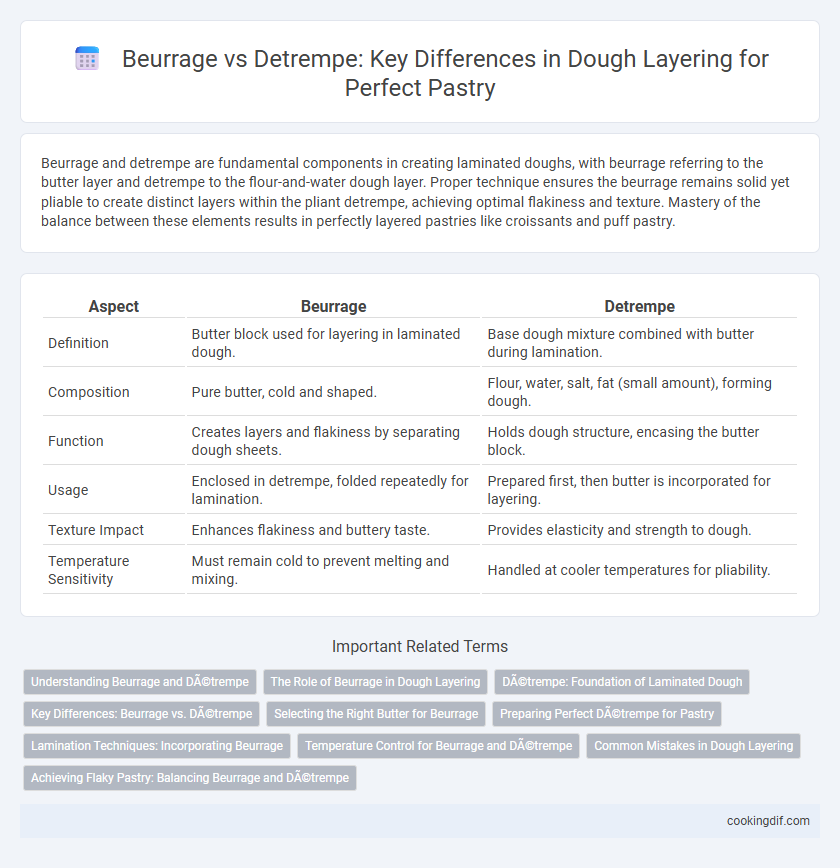Beurrage and detrempe are fundamental components in creating laminated doughs, with beurrage referring to the butter layer and detrempe to the flour-and-water dough layer. Proper technique ensures the beurrage remains solid yet pliable to create distinct layers within the pliant detrempe, achieving optimal flakiness and texture. Mastery of the balance between these elements results in perfectly layered pastries like croissants and puff pastry.
Table of Comparison
| Aspect | Beurrage | Detrempe |
|---|---|---|
| Definition | Butter block used for layering in laminated dough. | Base dough mixture combined with butter during lamination. |
| Composition | Pure butter, cold and shaped. | Flour, water, salt, fat (small amount), forming dough. |
| Function | Creates layers and flakiness by separating dough sheets. | Holds dough structure, encasing the butter block. |
| Usage | Enclosed in detrempe, folded repeatedly for lamination. | Prepared first, then butter is incorporated for layering. |
| Texture Impact | Enhances flakiness and buttery taste. | Provides elasticity and strength to dough. |
| Temperature Sensitivity | Must remain cold to prevent melting and mixing. | Handled at cooler temperatures for pliability. |
Understanding Beurrage and Détrempe
Beurrage is the layer of butter incorporated into dough to create flaky, layered textures through steam expansion, while detrempe is the basic dough mixture of flour, water, and sometimes fat that encloses the beurrage. The quality and temperature balance between beurrage and detrempe are critical for optimal lamination in pastries such as croissants and puff pastry. Proper understanding of how beurrage melts and detrempe stretches ensures distinct, airy layers and prevents butter leakage or dough rupture during baking.
The Role of Beurrage in Dough Layering
Beurrage, a high-fat butter layer, plays a crucial role in dough layering by creating distinct, flaky layers through steam generation during baking. Unlike detrempe, which is the basic dough mixture of flour, water, and fat, beurrage provides the essential fat content that separates and lifts the dough layers. Proper incorporation of beurrage ensures optimal lamination and texture in laminated pastries such as croissants and puff pastries.
Détrempe: Foundation of Laminated Dough
Detrempe serves as the foundational dough in laminated pastry preparations, composed of flour, water, salt, and a small amount of fat to create a pliable yet strong base. This mixture is critical for achieving the ideal elasticity and gluten development necessary for proper layering and expansion during baking. Mastery of detrempe consistency directly influences the quality and texture of classic pastries like croissants and puff pastry.
Key Differences: Beurrage vs. Détrempe
Beurrage refers to the high-fat butter layer incorporated between dough layers to create flakiness and richness, while detrempe is the base dough made from flour, water, salt, and sometimes a small amount of fat that encases the beurrage. The key difference lies in their function and composition: beurrage provides moisture and pliability for lamination, whereas detrempe offers structure and elasticity to hold the laminated layers together. Proper temperature control and technique during lamination ensure the distinct layers of beurrage and detrempe develop characteristic texture in pastries like croissants and puff pastry.
Selecting the Right Butter for Beurrage
Selecting the right butter for beurrage is crucial to achieving optimal dough layering, as high-fat, European-style butters with at least 82% fat content ensure better plasticity and water resistance. Beurrage butter must maintain a pliable yet firm consistency at refrigeration temperatures to prevent leakage and promote even lamination with the detrempe dough. The choice of butter directly affects the flakiness, rise, and overall texture of laminated pastries, making fat content and moisture level key factors in pastry success.
Preparing Perfect Détrempe for Pastry
Preparing perfect detrempe for pastry involves creating a smooth, elastic dough by combining flour, water, a small amount of butter, and salt, ensuring proper hydration and gluten development for optimal layering. Unlike beurrage, which is the butter block incorporated into the dough, detrempe forms the structural base that holds the butter during lamination. Achieving the right consistency in detrempe is crucial for even dough rolling, preventing butter leakage, and producing flaky, layered pastry textures.
Lamination Techniques: Incorporating Beurrage
Beurrage refers to the butter block used in lamination, providing the rich, flaky layers essential for puff pastry, while detrempe is the initial dough base that encases the beurrage. Proper lamination techniques involve evenly incorporating the beurrage into detrempe through precise folding and rolling, creating distinct layers that puff and separate during baking. Temperature control and butter consistency are critical to prevent merging of layers, ensuring a light, airy texture in the final pastry.
Temperature Control for Beurrage and Détrempe
Temperature control for beurrage and detrempe is critical to achieve optimal dough layering, as beurrage requires chilling to maintain butter's solidity while allowing plasticity for folding. Detrempe dough must be kept cool to prevent gluten overdevelopment and to ensure the butter does not melt prematurely during lamination. Maintaining distinct temperature zones, ideally around 4-10degC for beurrage and slightly cooler for detrempe, ensures a perfect balance between elasticity and butter consistency, resulting in crisp, flaky layers.
Common Mistakes in Dough Layering
Confusing beurrage with detrempe often leads to uneven dough layering, causing butter leakage and inconsistent puff pastry rise. Overworking the detrempe can result in gluten development, making the dough tough instead of flaky. Proper temperature control and precise butter incorporation prevent common mistakes like soggy layers and dough shrinkage.
Achieving Flaky Pastry: Balancing Beurrage and Détrempe
Achieving flaky pastry requires a precise balance between beurrage, the layer of butter, and detrempe, the dough base. Beurrage must remain solid and evenly distributed to create steam pockets during baking, while the detrempe should be pliable yet strong enough to encase the butter without breaking. Mastering the interaction of these elements ensures optimal lamination, resulting in delicate, crisp layers characteristic of premium puff pastry and croissants.
Beurrage vs détrempe for dough layering Infographic

 cookingdif.com
cookingdif.com